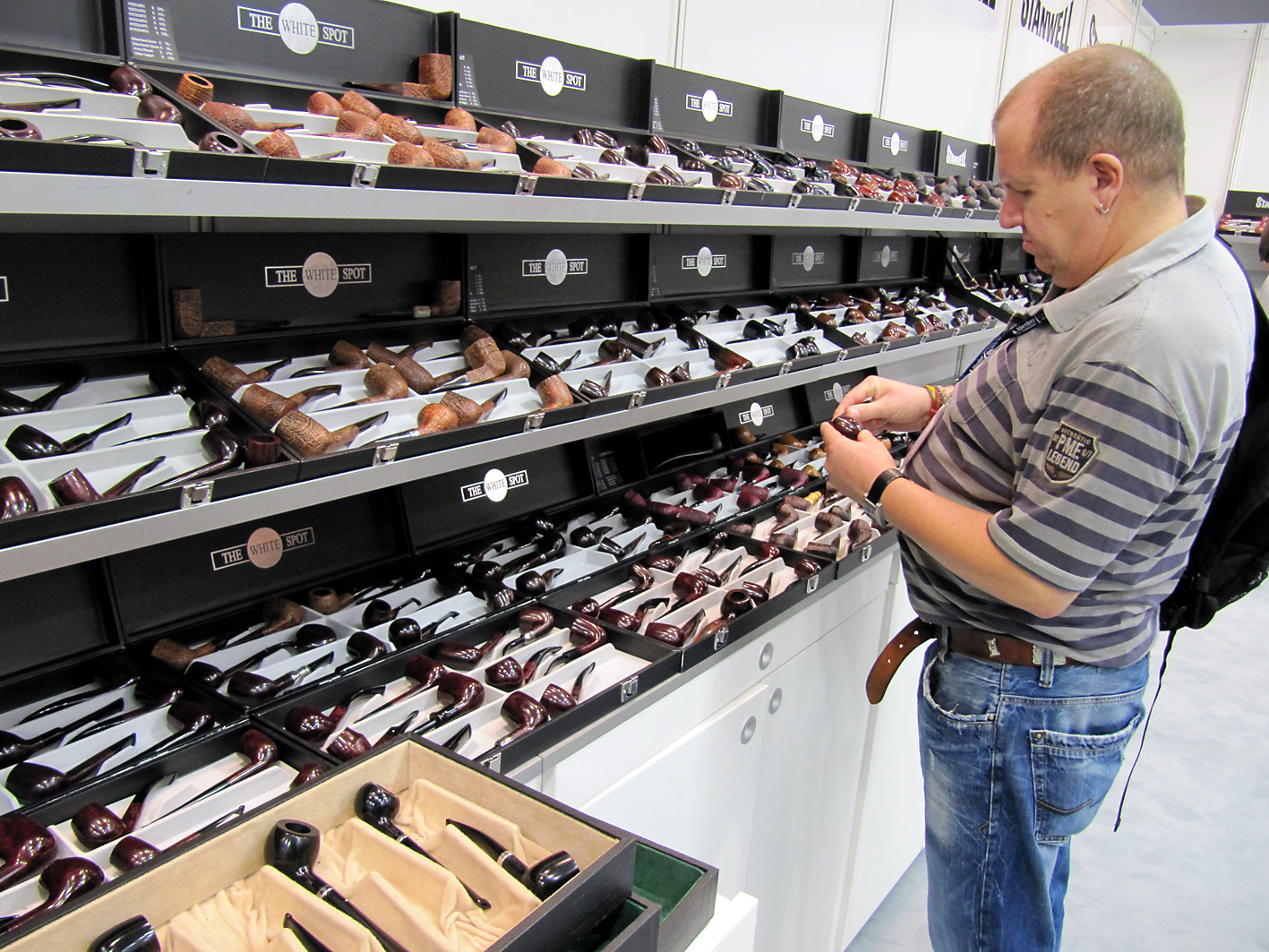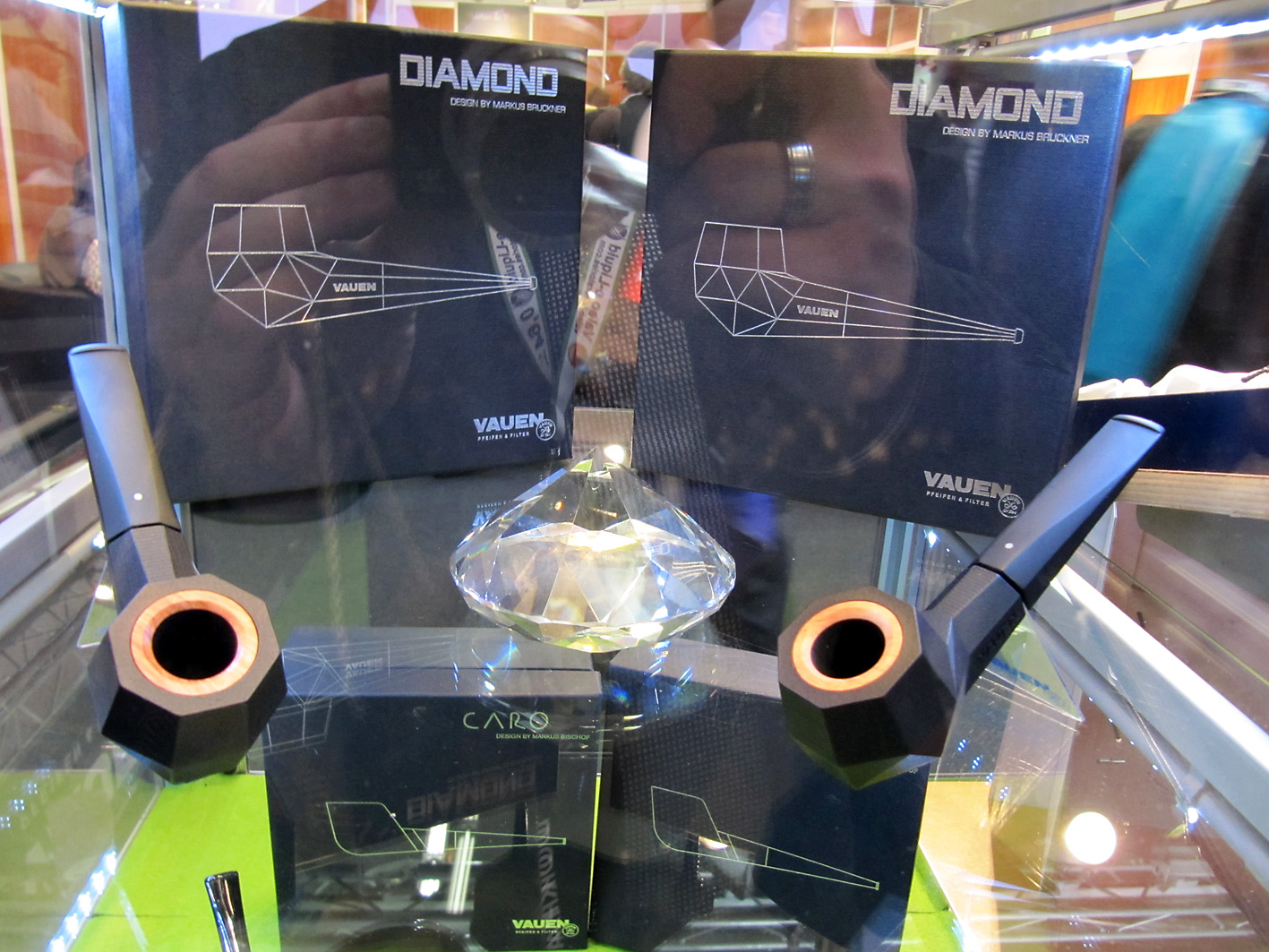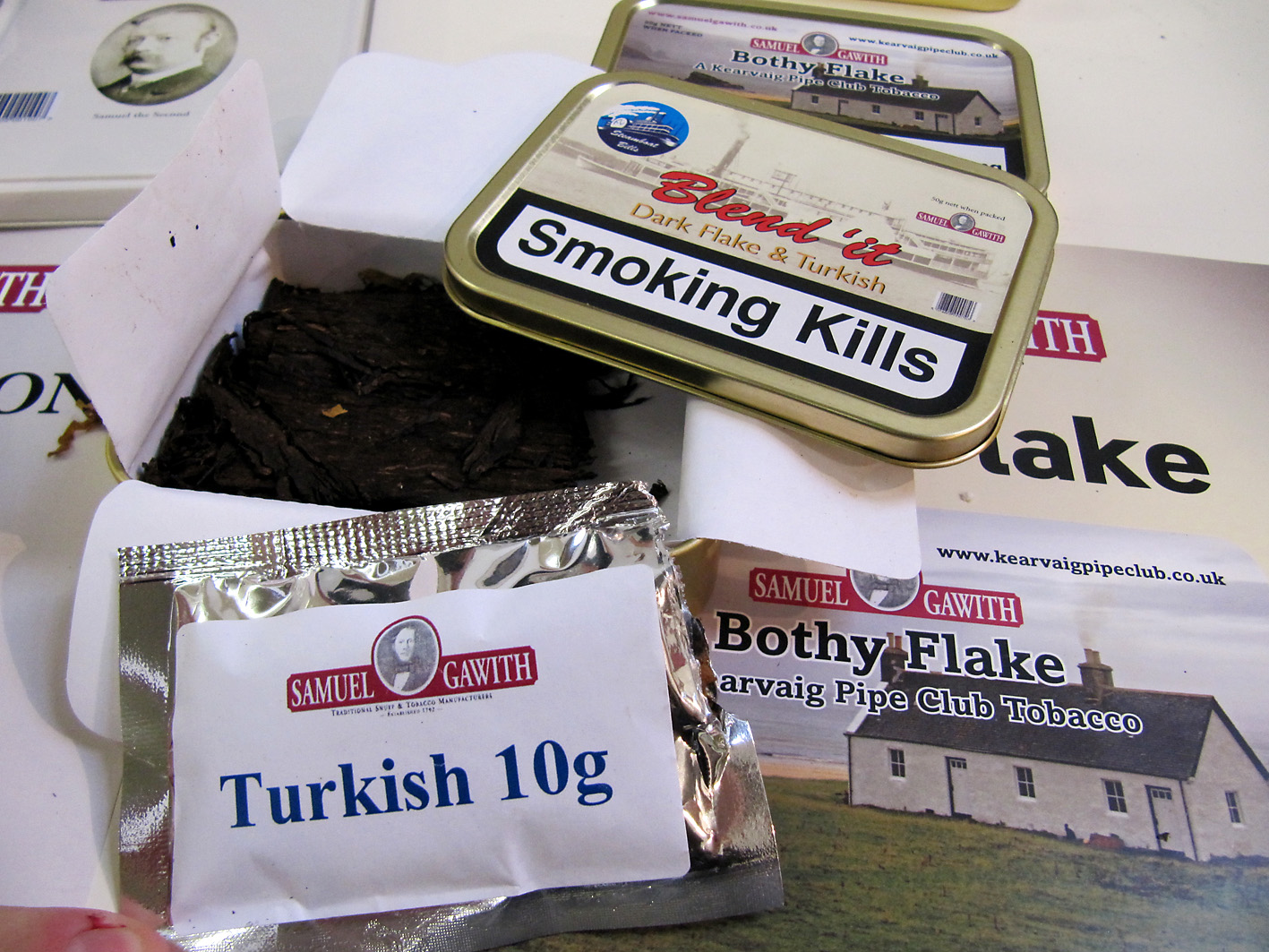As a lover of history I browse through e-bay searching for antique pipes once in a while. I very much like the thrill of owning and smoking a 100+ year old pipe, I see it as some sort of time machine. While enjoying such a smoke my mind drifts off and I think about how the world looked like when the pipe was made, who the previous owners were and what stories it could tell if it could speak. So on one of my searches I stumbled upon a gorgeous antique bulldog shaped pipe with a beautifully decorated silver rim and ring in almost pristine condition. Unfortunately the mouthpiece was missing. Probably it was made from amber and had broken a long time ago. Despite that I decided to bid on the pipe and to my delight I won! I asked Frisian pipe-maker Meindert if he could clean up the antique bulldog and make a new mouthpiece for it. He rose up to the challenge.
 In the meanwhile I looked up the silver-marks because I wanted to be sure of the production year and the company who made it. Dating the pipe proved to be simple, Birmingham marks from the year 1890! Holy crap, 125 years old! 1890.. The Sleeping Beauty ballet with music by Tchaikovsky was premièred, the second Sherlock Holmes novel (The Sign of the Four) was published, famous Dutch painter Vincent van Gogh died, The Picture of Dorian Gray by Oscar Wilde was published, American writer H.P. Lovecraft was born and the folding carton box we all know today was invented by Robert Gair. However, the maker of the antique bulldog was a bit more difficult to discover. Luckily the triangle logo on the shank with the letters “S Mc L” inside set me on the correct path and soon I found its creator: the Samuel McLardy company from Manchester.
In the meanwhile I looked up the silver-marks because I wanted to be sure of the production year and the company who made it. Dating the pipe proved to be simple, Birmingham marks from the year 1890! Holy crap, 125 years old! 1890.. The Sleeping Beauty ballet with music by Tchaikovsky was premièred, the second Sherlock Holmes novel (The Sign of the Four) was published, famous Dutch painter Vincent van Gogh died, The Picture of Dorian Gray by Oscar Wilde was published, American writer H.P. Lovecraft was born and the folding carton box we all know today was invented by Robert Gair. However, the maker of the antique bulldog was a bit more difficult to discover. Luckily the triangle logo on the shank with the letters “S Mc L” inside set me on the correct path and soon I found its creator: the Samuel McLardy company from Manchester.
The McLardy company thanks its existence to the entrepreneurial spirit of 1 person: Samuel McLardy, born in Glasgow in 1842. He was the son of a tobacconist who also produced his own clay pipes. In the paternal shop he must have learned the profession of pipe-maker. Shortly after his 20th birthday he decided to move to Manchester to start his own company. There is remarkably little known about the history of the factory. On an old advertisement it says “established 1865” so since then there must have been a steady growth. Within a couple of decades there was a massive production of clay pipes. Around 1895 the factory owned over 500 moulds which meant yearly production was around 5 million pipes! Similar to that of Dutch factory P. Goedewaagen & Zoon in that period.
Over time we find Samuel McLardy at different locations. Before 1880 that was Miller Street number 16 in Manchester and it is there where the shop grew to the size of a factory. In 1890 the company moved to Shudehill number 67 where it remained active until after 1910. At the new address they occupied an imposing factory building that you can see on the cover of an old catalogue beside this text. Such factory-illustrations have to be taken with a grain of salt, because often they are grossly exaggerated. The building had a high façade that could accommodate show rooms and an office and there were 4 floors for production and storage. After WWI we find McLardy headquarters in Swan Buildings at number 20 of the Swan Street but they also had several workshops at other addresses and that was certainly true for the pipe-making shops. It should be noted that these changes of address meant no large migration because they were close to each other.
The successful growth led the company to expansion, initially for the sale of products of their own. But shortly after 1900 a rapid decrease of the interest in the clay pipe as a smoking device in Western Europe brought many traditional pipe factories in financial problems. The widening to trading house was an option to overcome this problem and the Samuel McLardy company successfully implemented this. These trading activities were supported by the then new communication means such as telephone and telegram, both stated on the cover of the catalogue. There you can also see: “Importer of Tobacconists Fancy Goods”. So initially they became importer of all kinds of items sold in the tobacco industry.
With those items, for example beautiful briar pipes with silver mounting and buffalo horn mouthpieces, access was gained to the best specialist stores. With this activities the company increased its market share. A process that also was not strange for other firms. The production of such wooden pipes took place both in England and in the French Saint-Claude, once the global centre of the pipe production. By the way, the English briar industry and that of Saint-Claude was closely intertwined because the same families acted as an investor. About the export of the company not much data is known. Although finds of McLardy pipes in Canada, Australia and most of the West African coast proved that there was a substantial trade overseas.
During and after WWI the trade function at McLardy was widened further. The latest catalogue from the 1920’s mentioned this expansion. The activities of the company had been changed beyond recognition: they handled leather goods and fancy articles such as bags, handbags and purses in crocodile leather and calfskin. This assortment was soon expanded with collar–boxes, writing–boxes, school bags and baskets. But also with photo-frames, fire–screens, postcards albums and cigarettes albums. Other articles were clocks, framed paintings or engravings, lithographs, all kinds of mirrors and toys (including dolls and mechanical toys like trains). In short, the wholesale business of all conceivable industrial products without any limitation. Initially that seemed successful until the curtain quite suddenly fell for the McLardy company in 1929. The precise reason is not known, though the year points towards the Great Depression.
Back to Meindert. When he received the pipe he marvelled at its beauty and went to work. Before I knew it he had carefully removed the thin silverwork from the bowl and shank and slightly polished the ancient briar. I also asked if he could drill the smoking channel a little wider for a better draft. With steps of 0.1 mm he slowly broadened the channel until it had a diameter of 3.8 mm. Trusting his eye and experience he stopped there, fearing he would take to much “flesh” of the pipe. But the most intricate part of the restoration was drilling out the screw-thread from the mortise. Back in the days one screwed the mouthpiece onto the pipe. This may sound as blasphemy to some but I wanted a “modern” push/pull stem.
One evening I got a phone call, it was Meindert. I heard his slightly timid voice and knew something had gone wrong.. Earlier he was drilling away the screw-thread from the mortise and despite him being very careful his worst nightmare came true. The shank cracked. Luckily he was able to fix it with 2-component glue but he did not trust it completely. So he glued an aluminium tube inside the mortise to extra strengthen the fragile briar walls. The good news was that the crack would not be visible because the silver ring would cover it.
Another tricky job was the creation of the stem. The bulldog shape is pretty because of its flawless lines that go from the shank through the stem onto the end of the mouthpiece. Meindert had to re-create that but lacked the necessary tools that pipe-factories and professional pipe-workshops have to make the sharp angles, which made him somewhat nervous. “Round I can do, but those sharp angles.. Difficult..” I told him I trusted him and that he would surely pull it off. I send several pictures how the stem should look like so he had some reference examples and crossed my fingers. Some time later my patience was rewarded. Meindert succeeded in making the angles by placing the stem in the bank-screw and meticulously filing away the acrylic material. Yes, acrylic, not ebonite. It is Meindert’s favourite stem-material to work with and his acrylic (that he gets from Janzen Pfeifen) is of the highest quality.
I already knew I wanted to write a blogpost about the McLardy bulldog so while Meindert was slaving away I was doing some research about the brand on internet. There I came across a English antique-site which had a very interesting item: an old tobacco cutter for plugs, cakes and ropes made by… Samuel McLardy! The price was ok so I immediately bought it. When I was with Fred on the Inter Tabac fair in Dortmund this year they had such a cutter at the stand of DTM. It was used for the slicing of samples for their Salty Dogs plug. We both admired the tool and I silently vowed to buy one if I ever got the chance and the price was right.
 When the restoration of the McLardy bulldog neared its completion I mailed Meindert that I would pick up the pipe at his place together with my good friend Ed. Ed loves handworks and all the machinery and tools that comes with it. So I asked if Meindert was willing to show some of his skills when Ed and I were there and being a proud Frisian he said “sure”! In the car on the way there I was pretty nervous because I did not saw the finished result. Luckily I was not disappointed when we arrived. Meindert succeeded in placing back the beautifully decorated silverwork and given it an extra polish to make it shiny like a new pipe. Also the stem turned out to be very well made and I breathed a sigh of relief. Meindert had measured up the bowl and found a similar pipe on the internet so he had a clue of the dimensions of the stem. Briefly worded: I was a happy man!
When the restoration of the McLardy bulldog neared its completion I mailed Meindert that I would pick up the pipe at his place together with my good friend Ed. Ed loves handworks and all the machinery and tools that comes with it. So I asked if Meindert was willing to show some of his skills when Ed and I were there and being a proud Frisian he said “sure”! In the car on the way there I was pretty nervous because I did not saw the finished result. Luckily I was not disappointed when we arrived. Meindert succeeded in placing back the beautifully decorated silverwork and given it an extra polish to make it shiny like a new pipe. Also the stem turned out to be very well made and I breathed a sigh of relief. Meindert had measured up the bowl and found a similar pipe on the internet so he had a clue of the dimensions of the stem. Briefly worded: I was a happy man!
 The rest of the pleasant afternoon we spent talking and Meindert showed Ed how he did things. As a former metal worker he even was able to simply sharpen the edge of the tobacco cutter I had brought with me. Back home I tried it out on some Fayyum Kake and it worked like a charm. Meindert had put some of his biological smoking-paste on the inside of the bulldog bowl and I don’t know it was because of that, but I had a very satisfying smoke. I am just glad the pipe is “alive” again and hope it survives for another 125 years.
The rest of the pleasant afternoon we spent talking and Meindert showed Ed how he did things. As a former metal worker he even was able to simply sharpen the edge of the tobacco cutter I had brought with me. Back home I tried it out on some Fayyum Kake and it worked like a charm. Meindert had put some of his biological smoking-paste on the inside of the bulldog bowl and I don’t know it was because of that, but I had a very satisfying smoke. I am just glad the pipe is “alive” again and hope it survives for another 125 years.

























